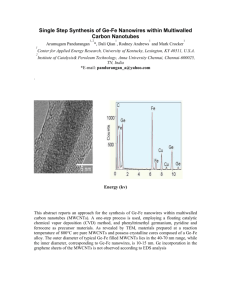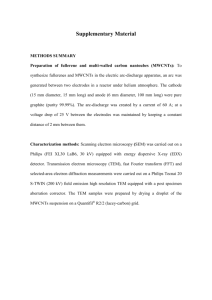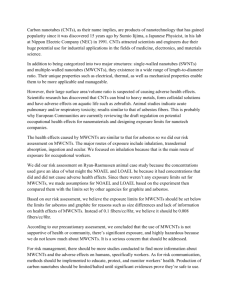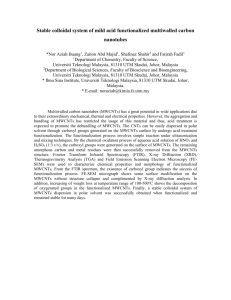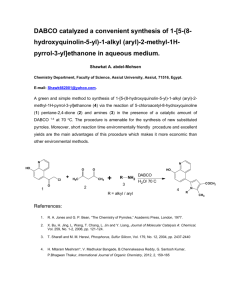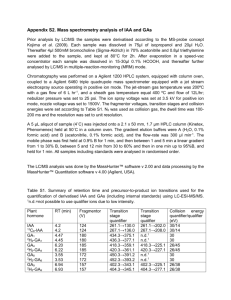Investigating the Mechanism for the Covalent Chemical
advertisement
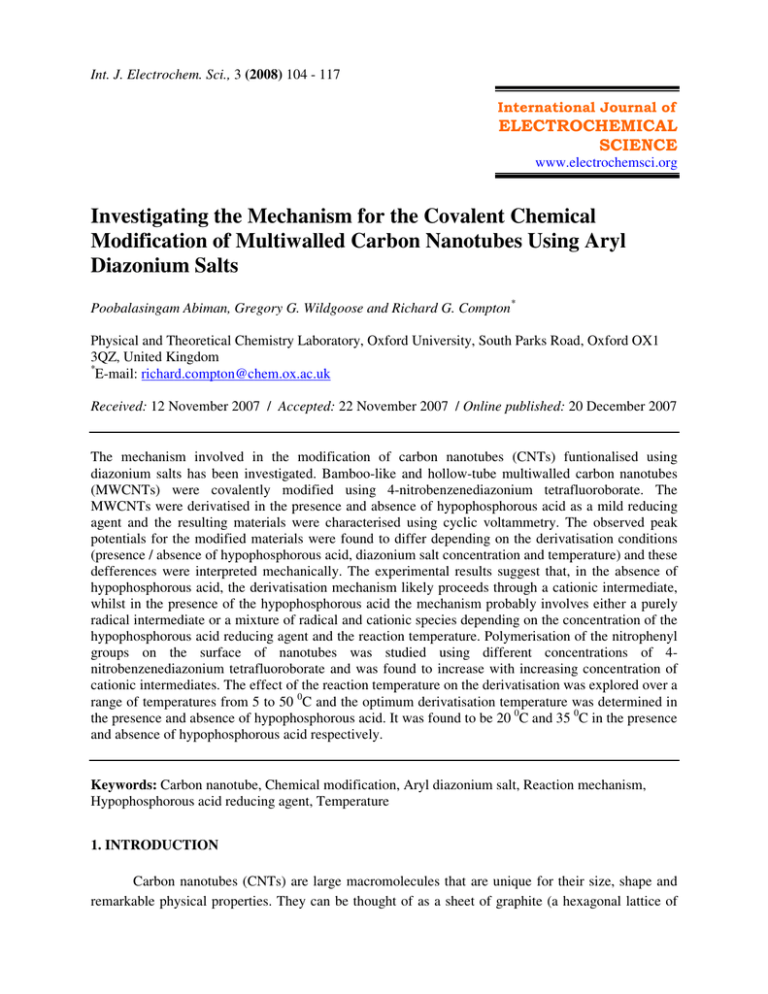
Int. J. Electrochem. Sci., 3 (2008) 104 - 117 www.electrochemsci.org Investigating the Mechanism for the Covalent Chemical Modification of Multiwalled Carbon Nanotubes Using Aryl Diazonium Salts Poobalasingam Abiman, Gregory G. Wildgoose and Richard G. Compton* Physical and Theoretical Chemistry Laboratory, Oxford University, South Parks Road, Oxford OX1 3QZ, United Kingdom * E-mail: richard.compton@chem.ox.ac.uk Received: 12 November 2007 / Accepted: 22 November 2007 / Online published: 20 December 2007 The mechanism involved in the modification of carbon nanotubes (CNTs) funtionalised using diazonium salts has been investigated. Bamboo-like and hollow-tube multiwalled carbon nanotubes (MWCNTs) were covalently modified using 4-nitrobenzenediazonium tetrafluoroborate. The MWCNTs were derivatised in the presence and absence of hypophosphorous acid as a mild reducing agent and the resulting materials were characterised using cyclic voltammetry. The observed peak potentials for the modified materials were found to differ depending on the derivatisation conditions (presence / absence of hypophosphorous acid, diazonium salt concentration and temperature) and these defferences were interpreted mechanically. The experimental results suggest that, in the absence of hypophosphorous acid, the derivatisation mechanism likely proceeds through a cationic intermediate, whilst in the presence of the hypophosphorous acid the mechanism probably involves either a purely radical intermediate or a mixture of radical and cationic species depending on the concentration of the hypophosphorous acid reducing agent and the reaction temperature. Polymerisation of the nitrophenyl groups on the surface of nanotubes was studied using different concentrations of 4nitrobenzenediazonium tetrafluoroborate and was found to increase with increasing concentration of cationic intermediates. The effect of the reaction temperature on the derivatisation was explored over a range of temperatures from 5 to 50 0C and the optimum derivatisation temperature was determined in the presence and absence of hypophosphorous acid. It was found to be 20 0C and 35 0C in the presence and absence of hypophosphorous acid respectively. Keywords: Carbon nanotube, Chemical modification, Aryl diazonium salt, Reaction mechanism, Hypophosphorous acid reducing agent, Temperature 1. INTRODUCTION Carbon nanotubes (CNTs) are large macromolecules that are unique for their size, shape and remarkable physical properties. They can be thought of as a sheet of graphite (a hexagonal lattice of Int. J. Electrochem. Sci., Vol. 3, 2008 105 carbon atoms) rolled into a cylinder. These structures have caused much excitement in recent years and a large amount of research has been carried out using them. CNTs have very interesting electronic, thermal and structural properties that vary depending on the morphology of the nanotube. CNTs can be broadly classified into two broad categories: singlewalled carbon nanotubes (SWCNTs) which can be considered to be formed by the rolling of a single layer of graphite into a cylinder and multiwalled carbon nanotubes (MWCNTs) can similarly be considered to be a coaxial assembly of SWCNTs, one within another. The diameters of CNTs can range from just a few nanometres in the case of SWCNTs to several tens of nanometres for MWCNTs. Depending on the conditions and chosen method of formation (e.g. chemical vapour deposition or the high voltage discharge arc method [1]). MWCNTs can be formed in a number of morphological variations. They can be formed as ‘‘hollow-tube’’, ‘‘herringbone’’ [1] or ‘‘bamboo-like’’ [2] as shown schematically in Figure 1. By comparison to graphite the ends of the MWCNTs can be considered as ‘‘edge-planelike’’, whilst the tube walls are ‘‘basal-plane-like’’ of a graphite sheet [3]. Figure 1. A schematic cross section of MWCNTs showing various morphologies The surface of MWCNTs can be modified in a variety of ways such as chemical bond formation between the modifying species and the MWCNT surface or physical adsorption of the modifier to the MWCNT surface [3]. One strategy for chemically modifying MWCNTs is via the action of free radical species, generated via the electrochemical oxidation or reduction of a solution-phase compound. Aryl diazonium salts are commonly used [4-9] with a one electron reduction, yielding dinitrogen and a free radical species. The electrogenerated radical can then covalently attach to the surface of the MWCNTs. However, the main drawback of this electrochemically activated modification is that the quantities of Int. J. Electrochem. Sci., Vol. 3, 2008 106 the derivatised MWCNTs produced are rather limited and are often difficult to remove from the electrode surface. Therefore alternative bulk derivatisation methods have been sought. MWCNTs can also be modified in bulk quantities with aryl diazonium salts through thermolysis [10], photolysis [11] or chemical reduction of the diazonium species [12-18] to form radical or cationic reactive intermediates which can then react with the surface of the MWCNTs to form covalent bonds. In recent years in our laboratory, we have developed a method for derivatising graphitic surfaces including MWCNTs with aryl diazonium salts in a chemically activated manner, via the reduction of the diazonium group using hypophosphorous acid [12-18]. These materials have subsequently been applied to drug delivery [19], water purification [20-22] and the development of improved pH sensors [12, 23]. However, this method has not been optimized and the mechanism involved in the modification, i.e. whether radical or cationic intermediates are involved and to what type of sites on the carbon surface these intermediates react with remains unknown. In the present study we derivatised both ‘‘hollow-tube’’ and ‘‘bamboo-like’’ MWCNTs (hMWCNTs and b-MWCNTs respectively) using 4-nitrobenzenediazonium tetrafluoroborate both in the presence and absence of the hypophosphorous acid reducing agent. The effect of temperature on the derivatisation was studied in the range between 5 0C and 50 0C. The resulting materials were characterized using cyclic voltammetry by abrasively immobilising each derivatised material onto a basal plane electrode. Depending on whether or not the hypophosphorous acid reducing agent was used in the modification the voltammetric wave shape and the observed peak potential for the derivatised materials was found to differ. Guided by chemical institution we speculate in the absence of any reducing agent the derivatisation mechanism likely proceeds via a cationic intermediate, whilst in the presence of hypophosphorous acid the mechanism proceeds through either a purely radical intermediate or a mixture of radical and cationic intermediates. The point of attachment and the chemical structures formed are determined by which intermediate the reaction proceeds through and result in the slight changes in the observed peak potentials. Therefore these differences in the peak potentials have been used to investigate the effects of varying the hypophosphorous acid, diazonium salt concentrations and the reaction temperature on the reaction mechanism. Finally the optimum reaction conditions were determined to ensure maximum derivatisation of both MWCNT morphologies. 2. EXPERIMENTAL PART 2.1. Reagents and Equipment All reagents were obtained from Aldrich (Gillingham, U.K.) and were of the highest grade available and used without further purification. All solutions and subsequent dilutions were prepared using deionised water from a Millipore (Vivendi, U.K.) UHQ-grade water system with a resistivity of not less than 18.2 MΩ cm at 25o C. Electrochemical experiments were carried out at room temperature in pH 7 buffer solution (0.05 M Na2HPO4 and 0.05 M NaH2PO4). All cyclic voltammetric measurements were made after degassing the solution with pure N2 gas (BOC gases, Guildford, Int. J. Electrochem. Sci., Vol. 3, 2008 107 Surrey, UK) for 30 minutes at room temperature. Both hollow-tube and bamboo-like carbon nanotubes with purity of 95% were purchased from Nanolab Inc. (Brighton, MA, USA) and were used without further purification. Electrochemical measurements were carried out using a computer controlled potentiostat, µAutolab computer (Eco-Chemie, Utrecht, Netherlands) with a standard three electrode configuration. A basal plane pyrolytic graphite electrode (bppg, 4.9 mm, diameter, Le Carbone Ltd. Sussex, UK) was used as working electrode. The counter electrode was a bright platinum wire, with a saturated calomel reference electrode (Radiometer, Copenhagen, Denmark) completing the cell assembly. Low temperature experiments were carried out in an ice bath and room temperature or elevated temperature experiments were performed in a double-walled glass cell, of 20 cm3 volume, which was connected to a heated water bath at the appropriate temperature. 2.2. Derivatisation of multiwalled carbon nanotubes with 4-nitrophenyl groups The chemically activated derivatisation of multiwalled carbon nanotubes (both hollow-tube, bamboo-like) were achieved as follows. 50 mg of hollow or bamboo-like MWCNTS was mixed with 10 cm3 of a solution containing 5 mM 4-nitrobenzenediazonium tetrafluoroborate, to which 10 cm3 of hypophosphorous acid (H3PO2, 50% w/w in water) was then added slowly. The derivatisation procedure was repeated on separate samples of MWCNTs at different temperatures over the range 550 0C with the reaction mixture stirred for 30 minutes at each temperature studied. After that the solution was filtered by water suction and washed with deionised water to remove any excess acid and finally with acetonitrile to remove any unreacted diazonium salt. The nanotubes derivatised with 4nitrophenyl group (NP-h-MWCNT and NP-b-MWCNT for the derivatised hollow and bamboo-like MWCNTs respectively) were then air-dried by placing inside a fume hood for a period of 12 h prior to use. Finally the same procedures were carried out as described above but with the addition of 10 cm3 of pure water rather than hypophosphorous acid added to the reaction mixture. 3. RESULTS AND DISCUSSION The voltammetric response of each of the derivatised MWCNT samples immobilised on a basal plane pyrolytic graphite (bppg) electrode was examined and then used to investigate the mechanism involved in the derivatisation. 3.1. Voltammetry of the derivatised MWCNTs at a bppg electrode First cyclic voltammetry of the NP-h-MWCNT, derivatised in the presence and absence of hypophosphorous acid, was carried out after performing a voltammetric characterization protocol to confirm the 4-NP groups are covalently attached as described elsewhere [12, 17, 24]. Upon first scanning the NP-h-MWCNT derivatised the presence of hypophosphorous acid at 20 0C in a reductive direction a large reduction wave is observed at ca. –0.74 V vs. SCE labelled as system 1 in figure 2a. Int. J. Electrochem. Sci., Vol. 3, 2008 108 However, no corresponding oxidation peak for the system 1 is observed when the scan direction is reversed at –1.0 V vs. SCE. This indicates that system 1 is chemically irreversible. On the other hand a new oxidation wave is observed at -0.035 V vs. SCE. On subsequent scans the corresponding reduction wave is observed at –0.14 V vs. SCE indicating an electrochemically quasireversible process, labelled system 2. This voltammetric behaviour for the generic example of nitrobenzene for the reduction of an arylnitro compound in water is illustrated in scheme 1. In this mechanism system 1 corresponds to the chemically and electrochemically irreversible reduction of the nitro group in a four-electron, fourproton process to form the corresponding arylhydroxylamine. This then undergoes an electrochemically almost-reversible two-electron, two-proton oxidation (system 2) to form the arylnitroso species. If the potential is only cycled around the region of the system 2 then a stable voltammetric response is observed. Therefore after the initial scan beyond system 1 is performed to generate the arylnitroso / aryhydroxylamine couple all further scans are only performed over system 2 between 0.4 and -0.5 V vs. SCE. Figure 2. Ten consecutive voltammograms of NP-h-MWCNT derivatised a) in the presence of hypophosphorous acid, b) in the absence of hypophosphorous acid; and NP-b-MWCNT derivatised c) in the presence of hypophosphorous acid, d) in the absence of hypophosphorous acid at 20 0C Int. J. Electrochem. Sci., Vol. 3, 2008 109 Scheme 1. The general mechanism for the aqueous electrochemical reduction of an arylnitro group illustrated here by nitrobenzene Cyclic voltammetry for the NP-h-MWCNT, derivatised in the absence of hypophosphorous acid at 20 0C was also carried out as described above (figure 2b). In this case the reduction peak of system 1 is found to be broadened and more ill-defined. Two set of oxidation peak potentials of system 2 were observed at -0.035 and 0.09 V vs. SCE with the peak at -0.035 V vs. SCE being almost identical with the previous case where NP-h-MWCNT derivatised in the presence of hypophosphorous acid. A simple calculation using the peak area of system 2 of the NP-h-MWCNT derivatised in the presence and absence of hypophosphorous acid indicates that the surface coverage of NP-h-MWCNT in the absence of hypophosphorous acid is more than three times that when hypophosphorous acid is used. Figures 2c and 2d show the voltammetric response of NP-b-MWCNT derivatised with and without hypophosphorous acid respectively. The voltammetry is almost identical in terms of the observed peak potentials depending on how the material was derivatised. 3.2. The effect of varying hypophosphorous acid concentration The effect of varying the concentration of hypophosphorous acid used in the modification of hollow-tube and bamboo-like MWCNTs using diazonium salts was investigated by performing a series of derivatisations at 20oC with the concentration of hypophosphorous acid added varying from 5.0M0.0001M. Figure 3a and b shows the overlaid first scans of NP-h-MWCNT and NP-b-MWCNT respectively derivatised using different concentrations of hypophosphorous acid. For NP-h-MWCNT at high concentration of hypophosphorous acid well defined single peak for system 1 at -0.74 V and oxidation peak at -0.035 V for system 2 are observed. When the concentration of hypophosphorous acid decreases a second peak appears in system 1 and system 2 at ca -0.93 and 0.09 V respectively and the peak currents gradually increase. Similar observation is observed in the case of NP-b-MWCNT except the peaks for system 1 are not as well defined as to those in NP-h-MWCNT. Int. J. Electrochem. Sci., Vol. 3, 2008 110 Scheme 2. Proposed mechanistic pathways for the derivatisation of MWCNTs through a) radical intermediate; b) cationic intermediate; c) reaction of cationic intermediate with carboxylic group; d) polymerization of cationic intermediates. Int. J. Electrochem. Sci., Vol. 3, 2008 111 Figure 3. Overlaid first scans of a) NP-h-MWCNT, b) NP-b-MWCNT, derivatised using different concentrations of hypophosphorous acid. 3.3. The effect of varying 4-nitrobenzendiazonium tetrafluoroborate concentration To investigate the effect of varying the concentration of 4-nitrobenzenediazonium tetrafluoroborate used in the modification of MWCNTs, a series of NP-h-MWCNT and NP-bMWCNT derivatisations were carried out in the absence of hypophosphorous acid at 20 0C using different concentration of 4-nitrobenzenediazonium solution varying from 1mM-10mM. The overlaid first scans of NP-h-MWCNT and NP-b-MWCNT derivatised with varying concentrations of 4nitrobenzenediazonium solution are shown in figure 4a and b respectively. In NP-h-MWCNT, at low concentrations of 4-nitrobenzenediazonium solution (lower than 2.5 mM), single well defined voltammetric peaks are observed for both system 1 and 2. At higher concentrations of 4nitrobenzenediazonium solution (higher than 2.5 mM) the second peak appears at -0.92 V and 0.09 V vs. SCE respectively for the system 1 and 2. Furthermore the second peak in the system 2 is found to shift to more positive potentials with increasing concentration of 4-nitrobenzenediazonium tetrafluoroborate. In the case of NP-b-MWCNT, even at low concentrations system 1 and 2 have two peaks and the second peak gradually shifts to positive potential value in system 2 with increasing concentration of diazonium salt. 3.4. Temperature effect in the derivatisation reaction The effect of temperature on the derivatisation of NP-h-MWCNT and NP-b-MWCNT (with and without hypophosphorous acid) was studied at a range of temperatures from 5-50 0C. Figure 5a and b show the first scan of NP-h-MWCNT, derivatised with and without hypophosphorous acid respectively, whilst figures 5c and d show the similar behaviour of the NP-b-MWCNTs. Note that whilst the derivatisation temperature varied the voltammetry was always performed at room temperature. Int. J. Electrochem. Sci., Vol. 3, 2008 112 Figure 4. Overlaid first scans of a) NP-h-MWCNT, b) NP-b-MWCNT, derivatised using different concentrations of 4-nitrobenzenediazonium tetrafluoroborate Figure 5. Overlaid first scan of a) NP-h-MWCNT, derivatised in the presence of hypophosphorous acid, b) NP-h-MWCNT derivatised in the absence of hypophosphorous acid, c) NP-b-MWCNT derivatised in the presence of hypophosphorous acid and d) NP-b-MWCNT derivatised in the absence of hypophosphorous acid at different temperatures. Int. J. Electrochem. Sci., Vol. 3, 2008 113 When the derivatisation is carried out at low temperatures using hypophosphorous acid as the reducing agent a single broad reduction peak is observed in the case of NP-h-MWCNT. As the reaction temperature increases up to 20 0C the peak becomes larger and above 20 0C the peak current again decreases, the peak broadens but the potential shifts to slightly more negative potentials. In contrast, when NP-h-MWCNT is made in the absence of hypophosphorous acid the peak current increases with increasing temperature, and the reduction peak becomes narrower and the second oxidation peak in system 2 at 0.09 V vs. SCE gradually increases until at higher temperatures the peak area (and hence the surface coverage of nitrophenyl groups) remains almost constant. Similar behaviour is observed in the case of NP-b-MWCNT (figure 5c and d). The surface coverage of nitrophenyl groups on the surface of h-MWCNT and b-MWCNT were calculated using the peak area for the NP-h-MWCNT and NP-b-MWCNT made with and without the hypophosphorous acid and is plotted as a function of the reaction temperature in figure 6. In the absence of any hypophosphorous acid the surface coverage gradually increases as the reaction temperature increases up to ca. 35 0C, after which the surface coverage remains almost constant. However in the presence of hypophosphorous acid the surface coverage passes through a maximum at ca. 20 0C likely reflecting competing mechanistic processes (see discussion below). 3.5. Discussion The most likely decomposition pathway for an aryldiazonium salt in the absence of any reducing agent is the entropically favoured loss of dinitrogen resulting in an aryl cation intermediate being formed. There are two possible decomposition pathways in the presence of a mild reducing agent such as hypophosphorous acid, one via the cation intermediate and the other involving the one electron reduction of the aryldiazonium species, liberating dinitrogen gas, and forming a neutral aryl radical intermediate. Any aryl radicals formed by the action of the hypophosphorous acid reducing agent can form a carbon-carbon bond with the H-terminated MWCNT surface via a hydrogen abstraction mechanism as shown in scheme 2a [21]. Whereas the same product can also be formed via the electrophilic addition (and subsequent loss of H+) of an aryl cation to the MWCNT surface as shown in scheme 2b [25]. As the same product is formed with either intermediate then the product can be reduced at the same potential and it is this structure that is likely responsible for the voltammetric features observed at slightly more positive potentials in system 1 in the case of NP-h-MWCNT or NP-b-MWCNT. There is an alternative reaction that the aryl cation intermediate can undergo which the aryl radical intermediate is unlikely to undergo. This is the reaction with surface carboxyl groups, which are known to decorate the edges of MWCNTs, [26] to form arylester products as shown in scheme 2c [27] In a previous report we have demonstrated that the reduction potential of 4-nitrophenyl groups attached to a carbon surface via the formation of an ester linkage is shifted slightly to more negative potentials than if the 4-nitrophenyl groups are directly attached through a carbon-carbon bond[21, 28] but the peak potential of system 2 (arylnitroso / arylhydroxylamine couple) is unchanged. Therefore we propose that as the peaks at more negative potentials for both NP-h-MWCNT and NP-b-MWCNT Int. J. Electrochem. Sci., Vol. 3, 2008 114 are only observed when the hypophosphorous acid reducing agent is not used, then the modification mechanism may go through an aryl cationic intermediate and these peaks are attributed to the modification of the CNT surface through the formation of an aryl ester. Figure 6. Surface coverages of a) NP-h-MWCNT, b) NP-b-MWCNT derivatised in the presence and absence of hypophosphorous acid at different temperatures. In addition to these reactions, the aryl cation intermediate can undergo reaction with nitrophenyl functionalised NP-h-MWCNT or NP-b-MWCNT, via the polymerization reaction shown in scheme 2d. If a high concentration of hypophosphorous acid is used for the derivatisation of NP-hMWCNT or NP-b-MWCNT, a single well defined peak is observed for system 1 and 2, whereas when low concentration hypophosphorous acid is used, two peaks appear in both systems (Fig. 2, 3 and 5). At higher concentration of hypophosphorous acid a larger proportion of the diazonium salt is reduced to form aryl radical intermediates rather than forming aryl cation intermediates. Some of radicals can Int. J. Electrochem. Sci., Vol. 3, 2008 115 then react with the MWCNT surface to form C-C bonds, whilst the majority simply react with the solvent to form 4-nitrobenzene in solution. At low concentration of hypophosphorous acid a greater proportion of cationic intermediates are formed which can then react with the MWCNT surface to form C-C bonds, or react with surface carboxyl groups to form an aryl ester linkage, or react with other 4-nitrophenyl groups to form a polymer on the surface. Note that the polymerization of aryl radicals is also possible via a Habstraction mechanism. However this requires two aryl radicals per propagation step whereas the cationic (electrophilic) polymerisation requires only one. The above observations indicate that the lifetime (and hence concentration of aryl radicals) near to the MWCNT surface is likely shorter than the aryl cation. Hence we speculate that polymerisation via the aryl radical mechanism is less likely. This was explored by varying the concentration of diazonium salt in the absence of hypophosphorous acid (Fig. 4). In both NP-h-MWCNT and NP-b-MWCNT at high concentration of diazonium salt the cation intermediate undergoes polymerization as enhanced by the appearance of a convoluted second peak in system 1 at more negative potentials causing the reduction peak to become broad and ill-defined. Analysis and interpretation of experimental results obtained at varying the temperature suggests at high concentrations of hypophosphorous acid and at modest temperatures the modification mechanism proceeds predominantly through a radical intermediate. As the concentration of hypophosphorous acid decreases the mechanism increasingly proceeds through two competing pathways, one the via the aryl radical intermediate, the other via the cationic intermediate. Both radical and cation can form the same C-C bonded product observed as the peak at more positive potentials, but in addition the cationic mechanism also allows the formation of 4-nitrophenylester and polymerized 4nitrophenyl groups via attack at surface carboxyl group sites and the modified MWCNT respectively. The surface coverage of nitrophenyl groups thus increases, the peak gets larger and broadens due to the convoluted contribution of the 4-nitrophenylester and polymeric groups to the voltammetric peaks labelled system 1 and 2. In the presence of hypophosphorous acid, ie. if the mechanism proceeds through radical intermediate, the surface coverage passes through a maximum at ca. 20 0C probably due to the increasing rate of competing side reactions such as hydrogen abstraction by the aryl radical intermediate from the solvent. If the mechanism proceeds via the cationic intermediate (i.e. without H3PO2) the surface coverage increase with increasing temperature up to ca. 35 0C after which the surface coverage remains almost constant. We speculate that this increase the surface coverage up to 35 0C likely reflects either an increase in the rate of decomposition of the nitrobenzenediazonium salt forming the cation intermediate or the rate of electrophilic attack of the MWCNT surface by the cation intermediate. In the former case the surface coverage of the derivatisation is limited by the rate of competing reactions such as solvolysis such that the number of reactive intermediates in the vicinity of the MWCNT surface that can undergo reaction reaches steady state. In the latter case the surface coverage may be limited by the number of available sites on the MWCNT surface and the number of 4-nitrophenyl groups already attached on the carbon surface. Int. J. Electrochem. Sci., Vol. 3, 2008 116 4. CONCLUSIONS In conclusion we have studied the mechanism involved in the covalent modification of CNTs using 4-nitrobenzenediazonium salts in aqueous media. The mechanism mainly depends on whether hypophosphorous acid is used as a reducing agent used or not and is found to proceed through either a radical intermediate or a cationic intermediate. In both mechanistic pathways a C-C bond is formed to the MWCNT surface, however in the case of the cationic intermediate two further products can be formed by reaction of the aryl cation intermediate with either surface carboxyl groups to form an ester linkage, or 4-nitrophenyl modified MWCNTs to form polymerised products. The covalent attachment of the modifier to the carbon surface via an ester linkage and/or the attachment through polymerization reaction change the peak potentials observed in the cyclic voltammetry of these materials. The derivatisation procedure has been optimised by studying the effect of temperature and concentration of H3PO2. It is found that using hypophosphorous the optimum temperature to achieve the maximum surface coverage is 20 0C. Higher surface coverages are always obtained in the absence of any added hypophosphorous acid with the optimum derivatisation temperature being in excess of 35 0 C. However these results in the modifying species attaching to various different reactive sites on the carbon surface leading to multiple closely separated peaks and shoulders being observed in the cyclic voltammetric response of such materials. In the presence of hypophosphorous acid only one single set of peaks is observed which is advantageous for electroanalytical applications of the modified carbon electrodes, e.g. the voltammetric measurements of pH using AQ-carbon which rely on accurately measuring changes in the observed voltammetric peak potential. ACKNOWLEDGEMENTS PA acknowledges support via a Dorothy Hodgkin Postgraduate Award (DHPA). GGW thanks St John’s College, Oxford, for a Junior Research Fellowship References 1. A. Leonhardt, M. Ritschel, K. Bartsch, A. Graff, C. Taschner and J. Fink, J. de. Phys. IV: Proc.11 (2001) Pr3/445 2. Y.Y. Wang, G. Y. Tang, F. A. M. Koeck, B. Brown, J. M. Garguilo and R.J. Nemanich, Diamond. Relat. Mater. 13 (2004) 1287. 3. G. G. Wildgoose, C. E. Banks, H. C. Leventis and R. G. Compton, Microchim.Acta. 152 (2006) 187. 4. A. J. Downard, Electroanalysis 12 (2000) 1085. 5. J. L. Bhar, J. Yang, D. V. Kosynkin, M. J. Bronikowski, R. E. Smalley and J. M. Tour, J. Am. Chem. Soc. 123 (2001) 6536. 6. M. Burghard and K. Kern, Electrochem. Soc. Int. 12 (2003) 21. 7. M. Knez, M. Sumser, A. M. Bittner, C. Wege, H. Jeske, S. Kooi, M. Burghard and K. Kern, J. Electroanal. Chem. 522 (2002) 70. 8. S. E. Kooi, U. Schlecht, M. Burghard and K. Kern, Chem. Int. Ed. Engl. 41 (2002) 1353. 9. P. R. Marcoux, P. Hapiot, P. Batail and J. Pinson, New. J. Chem. 28 (2005) 302. 10. J. L. Bahr and J. M. Tour, Chem. Mater. 13 (2001) 3823. 11. C. A. Dyke, M. P. Strewart, F. Maya and J. M. Tour, Synlett 1 (2004) 155. Int. J. Electrochem. Sci., Vol. 3, 2008 117 12. H. C. Leventis, I. Streeter, G. G. Wildgoose, N. S. Lawrence, L. Jiang, T. G. J. Jones and R. G. Compton, Talanta 63 (2004) 1039. 13. P. Abiman, A. Crossley, G. G. Wildgoose, J. H. Jones and R. G. Compton, Langmuir 23 (2007) 7847. 14. P. Abiman, G. G. Wildgoose and R.G. Compton, Electroanalysis 19 (2007) 437. 15. M. Pandurangappa, N. S. Lawrence and R. G. Compton, Analyst 127 (2002) 1568. 16. M. Pandurangappa, N. S. Lawrence, L. Jiang, T. G. J. Jones and R. G. Compton, Analyst 128 (2003) 473. 17. G. G. Wildgoose, M. Pandurangappa, N. S. Lawrence, L. Jiang, T. G. J. Jones and R. G. Compton, Talanta 60 (2003) 887. 18. S. Baranton and D. Bélanger, J. Phys. Chem. B 109 (2005) 24401 19. A. Bianco, K. Kostarelos, C. D. Partiods and M. Prato, Chem. Commun. 5 (2005) 571. 20. B. Šljuki , G. G. Wildgoose, A. Crossley, J. H. Jones, T. G. J. Jones and R. G. Compton, J. Mater. Chem. 16 (2006) 970. 21. G. G. Wildgoose, H. C. Leventis, I. J. Davies, A. Crossley, N. S. Lawrence, L. Jiang, T. G. J. Jones and R. G. Compton, J. Mater. Chem. 15 (2005) 2375. 22. G. G. Wildgoose, H. C. Leventis, A. O. Simm, J. H. Jones and R. G. Compton, Chem. Commun. (2005) 3694. 23. I. Streeter, H. C. Leventis, G. G. Wildgoose, M. Pandurangappa, N. S. Lawrence and R. G. Compton, J. Solid. State. Electrochem. 8 (2004) 718. 24. G. G. Wildgoose, H. C. Leventis, I. Streeter, N. S. Lawrence, S. J. Wilkins, L. Jiang, T. G. J. Jones and R. G. Compton, ChemPhysChem 5 (2004) 669. 25. R. Moehlau and R. Berger, Chem. Ber. 26 (1893) 2001. 26. C. A. Thorogood, G. G. Wildgoose, J. H. Jones and R. G. Compton, New. J. Chem. 31 (2007) 958. 27. A. Hantzsch, G. Osswald, W. Semple and J. Spear, Chem. Ber. 33 (1900) 2517. 28. A. T. Masheter, L. Xiao, G. G. Wildgoose, J. H. Jones and R. G. Compton, J. Mater. Chem. 17 (2007) 3515. © 2008 by ESG (www.electrochemsci.org)
